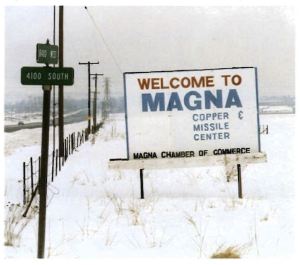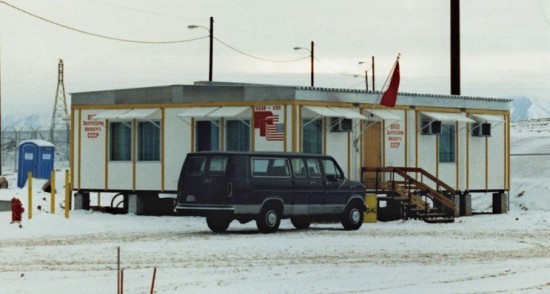Russian Inspection Station
The 1987 Intermediate-Range Nuclear Forces (INF) Treaty required the United States and the Soviet Union to verifiably eliminate all ground-launched ballistic and cruise missiles with ranges between 500 and 5,500 kilometers (310 and 3,418 miles). Distinguished by its unprecedented, intrusive inspection regime, including on-site inspections, the INF Treaty laid the groundwork for verification of the subsequent Strategic Arms Reduction Treaty (START I). The INF Treaty entered into force June 1, 1988, and the two sides completed their reductions by June 1, 1991, destroying 2,692 missiles.
July 2, 1988, the first 22-member Soviet INF inspection team arrived at the airport in Salt Lake City, Utah. They were met by representatives of the state governor, the city, news crews and local citizens. Soviet Colonel Anatoly Samarin described the greeting as a great ceremony and a very major event in Utah’s life. The Soviet team was given a tour of the treaty area at the Hercules nuclear rocket motor plant at Magna, Utah, where they soon began their monitoring and inspection work.
In late July 1988, the inspection building arrived by air cargo from the Soviet Union. The building was a group of four prefab modules that would be fitted together at the inspection site. It would become the Soviet Union’s data collection center. Also included were two small booths for monitoring road exits. The Soviet buildings and booths were inspected by U.S. officials at the airport and then transported to the Magna site and installed.
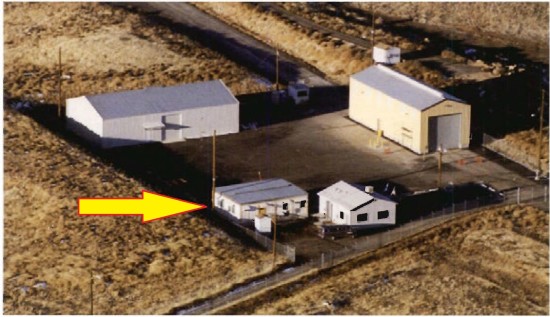
At Magna, the Soviet continuous portal monitoring inspection area contained four buildings. From left to right, the Soviet Warehouse, Soviet Data Collection Center (arrow), American Inspection Building, and the Environmental Shelter for examining vehicles exiting the rocket motor production plant.
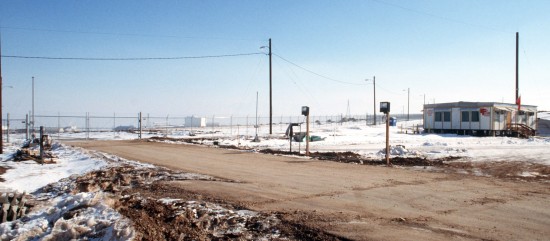
A view of the Soviet Data Collection Center on the grounds of Hercules, Inc., the manufacturer of propulsion components for the Pershing II missile. The building is occupied by Soviet inspectors who, to ensure U.S. compliance with the terms of the Intermediate-Range Nuclear Forces (INF) Treaty, monitor the departure or arrival of vehicles that could carry a missile stage.

The white and yellow Soviet Union monitoring booth on the left near a gate to Hercules, Inc., the manufacturer of propulsion components for the Pershing II missile. Under the terms of the Intermediate-Range Nuclear Forces (INF) Treaty, Soviet inspectors monitor the departure or arrival of vehicles to ensure U.S. compliance with the treaty.

One of the two Soviet Union monitoring booths near a gate to Hercules, Inc., the manufacturer of propulsion components for the Pershing II missile. (Photo courtesy Utah State Archives)

Jan. 14, 1989 Soviet inspectors and their American escorts stand among several dismantled Pershing II missiles as they view the destruction of other missile components. The missiles are being destroyed in accordance with the Intermediate-Range Nuclear Forces (INF) Treaty.
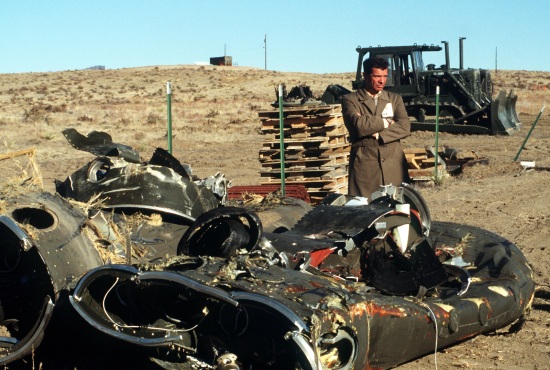
A Soviet inspector stands beside the mangled remnants of two Pershing II missile stages. Several missiles are being destroyed in the presence of Soviet inspectors in accordance with the Intermediate-Range Nuclear Forces (INF) Treaty.
The Soviet Union’s data collection center and monitoring booths remained at the Hercules plant in Magna, Utah, for the duration of the Intermediate-Range Nuclear Forces (INF) Treaty. The buildings continued to be used by Soviet inspectors for the subsequent Strategic Arms Reduction Treaty (START).
In 2001 the Soviet inspectors returned to the Soviet Union and the data collection center and booths were removed from the Hercules plant in Magna, Utah, and transported to Wendover, Utah, for storage and safekeeping. The buildings have remained untouched and contain the original Russian fixtures, appliances, furniture and monitoring equipment.

May 31, 2020, Wendover, Utah – Soviet Data Collection Center manufactured in the Soviet Union and transported to the United States in 1988.

May 31, 2020, Wendover, Utah – Soviet Data Collection Center manufactured in the Soviet Union and transported to the United States in 1988.

May 31, 2020, Wendover, Utah – Soviet Data Collection Center manufactured in the Soviet Union and transported to the United States in 1988.

May 31, 2020, Wendover, Utah – Soviet monitoring booth manufactured in the Soviet Union and transported to the United States in 1988.
Other Photographs, Articles and Information
1987 – Article – Los Angeles Times “The Washington Summit: Utah Town’s Residents Are Ready for the Russians: Treaty’s Missile Verification Pact Will Bring Soviet Team to Magna”
1988 – Article – Deseret News “Utah Welcomes Soviet Inspectors, Inf Obligations Could Keep Them Here up to 13 Years” and Associated Press “INF Treaty Verification Teams Arrive In Utah”
1994 – Government Report (272 page PDF) – “On-Site Inspections Under the INF Treaty”
2001 – Article – Deseret News “Work done — Russian inspectors to go home”
2007 – Photos – Lewis Colburn “The Inspection Stations Project”
2008 – Photos – Imagineering “Beached soviet espionage outposts”
2017 – Photos – Land Arts of the American West “Russian Inspection Station”
Information Sources and Credits
- Arms Control Association
- Associated Press
- Center for Land Use Interpretation
- Imagineering
- Land Arts of the American West
- The Inspection Station Project, Lewis Colburn
- The Los Angeles Times
- U.S. National Archives
- Utah State Historical Society
